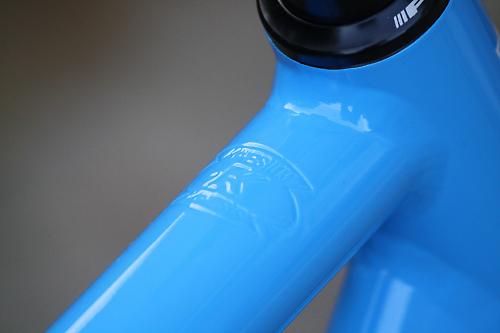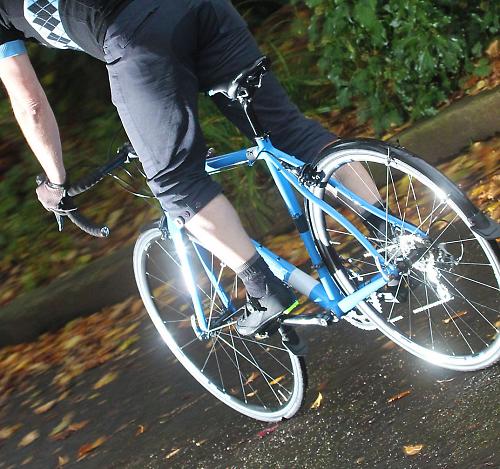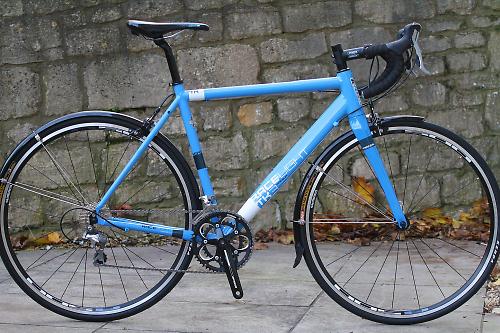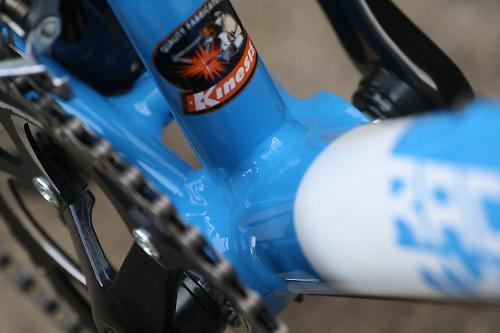- News
- Reviews
- Bikes
- Accessories
- Accessories - misc
- Computer mounts
- Bags
- Bar ends
- Bike bags & cases
- Bottle cages
- Bottles
- Cameras
- Car racks
- Child seats
- Computers
- Glasses
- GPS units
- Helmets
- Lights - front
- Lights - rear
- Lights - sets
- Locks
- Mirrors
- Mudguards
- Racks
- Pumps & CO2 inflators
- Puncture kits
- Reflectives
- Smart watches
- Stands and racks
- Trailers
- Clothing
- Components
- Bar tape & grips
- Bottom brackets
- Brake & gear cables
- Brake & STI levers
- Brake pads & spares
- Brakes
- Cassettes & freewheels
- Chains
- Chainsets & chainrings
- Derailleurs - front
- Derailleurs - rear
- Forks
- Gear levers & shifters
- Groupsets
- Handlebars & extensions
- Headsets
- Hubs
- Inner tubes
- Pedals
- Quick releases & skewers
- Saddles
- Seatposts
- Stems
- Wheels
- Tyres
- Health, fitness and nutrition
- Tools and workshop
- Miscellaneous
- Cross country mountain bikes
- Tubeless valves
- Buyers Guides
- Features
- Forum
- Recommends
- Podcast
review
£1,169.00
VERDICT:
Practical, comfortable winter bike with the spirit and stiffness of a racer
Weight:
9,720g
Contact:
www.kinesisbikes.co.uk
At road.cc every product is thoroughly tested for as long as it takes to get a proper insight into how well it works. Our reviewers are experienced cyclists that we trust to be objective. While we strive to ensure that opinions expressed are backed up by facts, reviews are by their nature an informed opinion, not a definitive verdict. We don't intentionally try to break anything (except locks) but we do try to look for weak points in any design. The overall score is not just an average of the other scores: it reflects both a product's function and value – with value determined by how a product compares with items of similar spec, quality, and price.
What the road.cc scores meanGood scores are more common than bad, because fortunately good products are more common than bad.
- Exceptional
- Excellent
- Very Good
- Good
- Quite good
- Average
- Not so good
- Poor
- Bad
- Appalling
The Kinesis Racelite TK3 is a bike that's truly greater than the sum of its parts, a proper race bike for all conditions that's just as at home on the commute, the chaingang or trundling round the lanes.
Phrases like 'power bulged top tube' and 'tapered carbon monocoque fork' are normally seen in the marketing blurb of the latest handbuilt carbon superbike - not aluminium steeds designed for mudguards and 28mm tyre clearance. The Kinesis is a little different though.

Just because its snowing outside doesn't mean those racing aspirations have gone into hibernation. What you need is a bike that can be ridden hard in your race position regardless of the conditions, something like the TK3.
The frame is manufactured using Kinesium tubing, an enhanced 6000 series alloy developed by Kinesis's engineers and built into a frame 25% stronger than a 6061 alloy frame with comparative weight. The first thing your eyes are drawn to is that bulging top tube as it leaves the head tube, travelling back about a third of the length. As you can imagine it's there for stiffness, resisting the forces from the front end under hard efforts and a by-product is a larger weld area at the head tube.

Tapered head tubes continue their march for domination (Genesis have also followed this route on the recently reviewed Equilibrium Ti) and as usual we've got a 1.5' at the bottom shrinking to 1.25' at the top of the 150mm tube.
The down tube ovalises as it travels towards the BB shell, maximising the weld area again in that quest for power transfer. Out the other side come the oversize chainstays, curving out to the dropouts in a gentle arc; there isn't going to be much flex here once the hammer goes down.

The seatstays have an hourglass profile, a well used tactic to bring some damping to what could otherwise harsh frame. A full set of rack and mudguard mounts are just what you want on a winter steed plus the mech hanger is replaceable, a must as your chances of decking are going to increase in wet and greasy conditions.
Tracer 1.5 - it sounds more like a fighter plane than a fork but it certainly looks like it means business. Full UD carbon fibre with a monocoque construction, on a winter bike? Yes please. The fork legs are curved ever so slightly inwards, mimicking the hourglass seatstays for vibration damping. Mudguard eyelets are included and with the use of deep drop brake callipers there is clearance for larger volume tyres.

Our test bike is the full bike option but you can also go for the frame and fork only which includes the seat clamp and tapered headset all for £549.99. For £1169 you can have this build, except with Freedom tyres rather than the Kendas you see here.
What about the colour? I like it but my riding buddies were split 50/50 on the bright blue. I think it lifts the mood as you head out for yet another commute or training ride in the pouring rain or fog. There is a metallic grey option though if that's more your cup of tea. The paint job, as always with Kinesis frames is beautiful, a decent thick coat along with smooth welds gives a look of a frame costing twice as much. Little touches like the engraved bulge on the top tube increases strokability too.

It's a common sense build, predominantly Tiagra 10spd for the gear shifting duties with just the chainset being supplied by FSA in the guise of their Vero compact. FSA also supply the bar and stem while Shimano is on board for the wheels, the solid and dependable R501's. Kinesis's own brand seatpost and saddle finish things off along with Tektro brakes and full chromoplastic mudguards. Okay it's not exactly exciting or lightweight (the full bike comes in at 9.72kg or 21.4lb) but dependable and will stand up to the worst the weather can chuck at it.
Looking over the geometry it shows that our 54cm frame has a 55.6cm top tube, a good 10-15mm longer than you'd expect but the extra stretch does put you in a nice low position and don't forget the TK3 is all about performance. Angles, seat and head are 73.5° giving a good balance of lively handling and predictability while the 100.6cm wheelbase gives a stable platform on iffy road surfaces.

As soon as the pedals are in motion you realise the Kinesis is more than just a winter trainer, it's literally a race bike that just happens to take proper mudguards and is carrying a little bit of excess weight. The handling is quick and gives huge amounts of feedback allowing you to really push on at a fair lick even on wet roads. You know where you are with it, how much you can lean, what grip you've got, all this information comes back through the bars and saddle allowing you to make micro changes maintaining speed and fluidity in a group.
Whether you think its necessary or not that tapered headtube makes for a very stiff front end. You'll notice it most on twisting descents as you load it up the front end to change direction. The TK3 is brilliantly balanced giving you huge confidence in its ability. The Tektro R539 brakes work really well grabbing hold of the rim, scrubbing off speed quickly and once again that front end is unflustered under heavy braking.

The TK3 is much more comfortable than I expected. Oversized alloy tubing normally means a harsh ride but those hourglass seatstays and fork legs are obviously doing as they're designed to do. Five to six hour rides are completed in relative comfort thanks to the frame and the bit of extra give of the 25mm tyres.
While it's a joy to ride hard you don't have to be giving it the full beans all of the time to enjoy the ride. Thanks to that comfort I mentioned you can happily sit up a bit and just enjoy the scenery. The ride is still as engaging and you can cover miles and miles without realising it.

The Tiagra shifting is consistent, if a little vague but always stands up to plenty of abuse from the elements. Moving to 10spd doesn't seem to have affected shifting with a dirty chain anymore than the 9spd did. A decent spread of gears will get you up the majority of climbs in the saddle and if you do have to stand the frame remains stiff beneath you - so you feel as though you're making rapid progress even if in reality you aren't.
The R501 wheels take all that back lanes and potholes can throw at them, remaining true and smooth running. They are heavy but it's a compromise worth making for longevity on this type of bike. Acceleration from a standing start takes a bit of effort but once rolling increasing speed isn't an issue. Thankfully the Kenda tyres won't be coming on the production models as they certainly don't bring anything to the ride. Grip is okay but they puncture easily and give a pretty dead ride.

The TK3 has become the bike to grab out of the shed at the moment, regardless of the weather or if I'm commuting, out on a club run or going for a long base miler. To call the TK3 just a winter bike does it a disservice as it is a proper all rounder that can be used year round, rain or shine to get the miles in on.
I did suffer a bit from lower back pain due to the stretched out position but thats more down to a few too many car/bike interactions and resulting injuries.

I'd just drop a size if I was buying and run plenty of seatpost. With regards to the price it's well specced for the cash with a lot of the budget going into the frame - which means its ripe for upgrades if you wanted to use it in early season races where the weather can still be dodgy.
All in all though it's a bike that's going to see you through years of service and if you use it for commuting that outlay is going to be recouped very quickly. In a lot of ways the Kinesis reminds me of the Ragley Cragg Vale tested back in May 2011 - also a bike that was a joy to ride, regardless of whether it was wet, dry, winter or summer. This has the advantage of being able to run big tyres with guards on top of that.
(Word from Kinesis is that the TK3 has been a massive success so much so that the initial batch sold out in record time… the good news is there's more on the way they will be landing in January and you can pre-order now.)
Verdict
Practical, comfortable winter bike with the spirit and stiffness of a racer.
road.cc test report
Make and model: Kinesis Racelite TK3
Size tested: 54
About the bike
State the frame and fork material and method of construction. List the components used to build up the bike.
Hydroformed Kinesium alloy tubing with a 'power bulge' top tube and tapered head tube for stiffness
tapered steerer carbon fibre monocoque fork
Tiagra 10spd shifters and mechs
FSA Vero compact chainset
Tektro deep drop calipers
Shimano R501 wheels
FSA bar and stem
Kinesis saddle and seatpost
Tell us what the bike is for, and who it's aimed at. What do the manufacturers say about it? How does that compare to your own feelings about the bike?
The TK3 is designed as an all year round training bike with race geometry. Kinesis say its become the staple product for the commited racer through the winter months. Its a pretty spot on description as you can train hard on it in your racing position year round
Frame and fork
Overall rating for frame and fork
9/10
Tell us about the build quality and finish of the frame and fork?
Top notch, smooth welding and the engraved logo on the top tube are neat touches. The TK3 feels solid and looks well built and as always Kinesis frames are finished with a deep paintjob.
Tell us about the materials used in the frame and fork?
Kinesium is developed by the engineering bods at Kinesis. Its a 6000 series alloy thats manipulated to create a material thats extremely stiff for its weight.
The fork is uni-directional carbon fibre, the fibres are laid in the direction that will give the best ride characteristics.
Tell us about the geometry of the frame and fork?
How was the bike in terms of height and reach? How did it compare to other bikes of the same stated size?
For a 54cm the top tube is long at 55.6cm which means it can be a bit of a stretch if you're not using it for performance rides. Other than that though its all pretty usual.
Riding the bike
Was the bike comfortable to ride? Tell us how you felt about the ride quality.
Yes, its stiff as its a race bike but not so much that it's shaking your teeth out.
Did the bike feel stiff in the right places? Did any part of the bike feel too stiff or too flexible?
Yes, front end and bottom bracket areas have no play whatsoever.
How did the bike transfer power? Did it feel efficient?
Very well, nothing is wasted through the frame and fork.
Was there any toe-clip overlap with the front wheel? If so, was it a problem?
Yes a bit due to the mudguards.
How would you describe the steering? Was it lively, neutral or unresponsive? Lively.
Tell us some more about the handling. How did the bike feel overall? Did it do particular things well or badly?
The handling is great, predictable but still exciting with loads of feedback.
Which components had the most effect (good or bad) on the bike's comfort? would you recommend any changes?
A lot of it is down to the hourglass seatstays but the Kinesis saddle is also pretty comfy.
Which components had the most effect (good or bad) on the bike's stiffness? would you recommend any changes?
The bars and stem are stiff and there is very little flex in the Vero cranks either.
Which components had the most effect (good or bad) on the bike's efficiency? would you recommend any changes?
The wheels due to their weight scrub off a bit of the performance but its an acceptable trade off for longevity.
Rate the bike for efficiency of power transfer:
9/10
Rate the bike for acceleration:
7/10
21lb takes a bit of effort from a standing start
Rate the bike for sprinting:
8/10
Rate the bike for high speed stability:
9/10
Rate the bike for cruising speed stability:
9/10
Rate the bike for low speed stability:
7/10
the stretched out position can make it a bit twitchy at slower speeds
Rate the bike for flat cornering:
8/10
Rate the bike for cornering on descents:
9/10
Rate the bike for climbing:
8/10
It's weight counts against it but it climbs well in terms of position and getting the power down.
The drivetrain
Rate the drivetrain for performance:
7/10
Rate the drivetrain for durability:
8/10
Rate the drivetrain for weight:
7/10
Rate the drivetrain for value:
7/10
Tell us some more about the drivetrain. Anything you particularly did or didn't like? Any components which didn't work well together?
It all works well although the Tiagra's shifting isn't as solid and precise as say Campag's Xenon.
Wheels and tyres
Rate the wheels and tyres for performance:
7/10
Rate the wheels and tyres for durability:
8/10
Rate the wheels and tyres for weight:
6/10
Rate the wheels and tyres for comfort:
7/10
Rate the wheels and tyres for value:
8/10
Tell us some more about the wheels and tyres.Did they work well in the conditions you encountered? Would you change the wheels or tyres? If so, what for?
The wheels are good, they saw a lot of water, mud and potholes and are still running smooth and true. The Kenda tyres are pretty dull but these won't be part of the production build.
Controls
Rate the controls for performance:
8/10
Rate the controls for durability:
8/10
Rate the controls for weight:
7/10
Rate the controls for comfort:
8/10
Rate the controls for value:
7/10
Tell us some more about the controls. Any particularly good or bad components? How would the controls work for larger or smaller riders?
FSA finishing kit is on so many bike builds now and you don't get to that level without good quality, reliable kit. The compact drop bars as always are a good compromise and work well for small hands. Tiagras shifters also come with shims to move the levers closer to the bar.
Your summary
Did you enjoy riding the bike? Yes.
Would you consider buying the bike? Yes.
Would you recommend the bike to a friend? Yes.
Rate the bike overall for performance:
8/10
Rate the bike overall for value:
8/10
About the tester
Age: 34 Height: 180cm Weight: 76kg
I usually ride: Ribble Winter Trainer for commuting, Genesis Flyer My best bike is: Sarto Rovigo
I've been riding for: 10-20 years I ride: Every day I would class myself as: Expert
I regularly do the following types of riding: time trialling, commuting, club rides, sportives, fixed/singlespeed,
Since writing his first bike review for road.cc back in early 2009 senior product reviewer Stu has tested more than a thousand pieces of kit, and hundreds of bikes.
With an HND in mechanical engineering and previous roles as a CNC programmer/machinist, draughtsman and development engineer (working in new product design) Stu understands what it takes to bring a product to market. A mix of that knowledge combined with his love of road and gravel cycling puts him in the ideal position to put the latest kit through its paces.
He first made the switch to road cycling in 1999, primarily for fitness, but it didn’t take long for his competitive side to take over which led to around ten years as a time triallist and some pretty decent results. These days though riding is more about escapism, keeping the weight off and just enjoying the fact that he gets to ride the latest technology as part of his day job.
Latest Comments
- Simon E 5 hours 28 min ago
Speak for yourself....
- David9694 5 hours 31 min ago
Public path across Christchurch civic centre car park could stop sale, claims Friar’s Cliff Residents Association...
- David9694 6 hours 22 min ago
Morrisons supermarket car park cordoned off after car crash https://www.theargus.co.uk/news/25002751.morrisons-supermarket-car-park-...
- Matt Page 6 hours 40 min ago
It sounds like the shoes you have are the Boa L6, and they work well, although the Li2 is better, especially with dual-dial shoes. ...
- Oldfatgit 6 hours 46 min ago
I'm going to admit that I thought that [sic] was an indication of a spelling mistake .. and only after looking it up, I realise that I was *sort*...
- Oldfatgit 6 hours 52 min ago
This is a confusing 'roundabout'...
- AidanR 7 hours 39 min ago
I wouldn't be so sure that he'll get away with this just because cops routinely shoot people and get off. The law is very different as effectively...
- Rendel Harris 8 hours 49 min ago
What he wrote is a direct word for word quote from the King James Bible, one of the very greatest achievements of written English in the history of...
- stonojnr 8 hours 55 min ago
From what I understood from lawyers, there's nothing preventing a charge of manslaughter being applied in addition to death by dangerous driving...
- Dnnnnnn 9 hours 42 min ago
Nocturnal implementation isn't ideal but I think your final sentence captures why it was probably necessary....

























Add new comment
9 comments
One of these, but built to accommodate discs would be the perfect bike in my opinion. I would certainly move to one from my T2.
I built up the T2 last year and have it kitted out in 105 with m/guards.
These are OK as winter bikes - obviously extremely expensive for what they are but they do have good geo and are ideal for the winter thing. Considering the state of the roads around the Southdowns I think the bike is ideal for all year use. I'm not even going to take the m/g's off for the summer.
I still can't manage to get the TT to measure 55.6 cm or 556 mm no matter how many times I measure it. But as above I think the geo is OK for me so don't mind it being shorter than stated.
Did have a big problem with the first frame but after some discussion with Kinesis they kindly sent through a replacement and were generally very helpful.
If I hadn't brought the T2 I would definitely buy the T3 (after robbing a bank or BS {only joking}).
off-topic, but a serious question - what brand are the 3/4 shorts the rider in the picture is wearing? Need a decent pair for commuting as lycra isn't that practical every day
Don't know what PACMAC rides in the summer (steel or carbon I guess?) but I've found the standard Alu frame (T2) with a carbon fork, seatpost and 25mm tyres to be more than comfy enough. I was pleasantly surprised how comfy the back end is compared to my last alu bike.
I've got it set up as per my summer bike and with a short-ish stem it rides just as well - albeit a bit heavier than carbon. Depends what you want it for: a winter trainer to replicate the fit of your best bike or an audax/sportive mile muncher. It's better at being the former than the latter, albeit its still comfy enough for me for an all day ride.
Thanks for the comments. Top tube is slightly longer than normal because the frameset is designed to accommodate larger tyres and full guards without the need for an overly slack head-angle to avoid excessive toe-overlap. Riders normally find it can be easily sorted with an adjustment on stem length. You can add up to 40mm of spacers if you need to bring the front end up.
Hope this helps.
Dom. Kinesis UK.
I discounted this as an all-rounder due to the comparative length of the top-tube.
Dropping a size will shorten the TT, but you'll end up with a more dropped front end, so you'd better be flexible otherwise your back will be complaining.
Had this on pre-order and got it in October when the forst batch arrived. Mine has the 2012 build i.e. Tiagra chainset not FSA,Kenda tyres etc but its a really confortable ride for a winter bike. I got a smaller frame than normal and changed the bars from 44cm to 42 cm.
Love it!
good test, good review